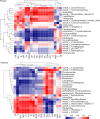Different Responses of Bacterial and Archaeal Communities in River Sediments to Water Diversion and Seasonal Changes
- PMID: 33917984
- PMCID: PMC8068392
- DOI: 10.3390/microorganisms9040782
Different Responses of Bacterial and Archaeal Communities in River Sediments to Water Diversion and Seasonal Changes
Abstract
In recent years, different responses of archaea and bacteria to environmental changes have attracted increasing scientific interest. In the mid-latitude region, Fen River receives water transferred from the Yellow River, electrical conductivity (EC), concentrations of Cl- and Na+ in water, total phosphorus (TP), and Olsen phosphorus (OP) in sediments were significantly affected by water transfer. Meanwhile, temperature and oxidation-reduction potential (ORP) of water showed significant seasonal variations. Based on 16S rRNA high-throughput sequencing technology, the composition of bacteria and archaea in sediments was determined in winter and summer, respectively. Results showed that the dominance of bacterial core flora decreased and that of archaeal core flora increased after water diversion. The abundance and diversity of bacterial communities in river sediments were more sensitive to anthropogenic and naturally induced environmental changes than that of archaeal communities. Bacterial communities showed greater resistance than archaeal communities under long-term external disturbances, such as seasonal changes, because of rich species composition and complex community structure. Archaea were more stable than bacteria, especially under short-term drastic environmental disturbances, such as water transfer, due to their insensitivity to environmental changes. These results have important implications for understanding the responses of bacterial and archaeal communities to environmental changes in river ecosystems affected by water diversion.
Keywords: 16SrRNA high-throughput sequencing; archaea; bacteria; river sediments; seasonal changes; water transfer.
Conflict of interest statement
The authors declare no conflict of interest. The funders had no role in the design of the study; in the collection, analyses, or interpretation of data; in the writing of the manuscript, or in the decision to publish the results.
Figures









References
-
- Bello M.O., Thion C., Gubry-Rangin C., Prosser J.I. Differential sensitivity of ammonia oxidising archaea and bacteria to matric and osmotic potential. Soil Biol. Biochem. 2019;129:184–190. doi: 10.1016/j.soilbio.2018.11.017. - DOI
Grants and funding
LinkOut - more resources
Full Text Sources
Other Literature Sources
Miscellaneous

